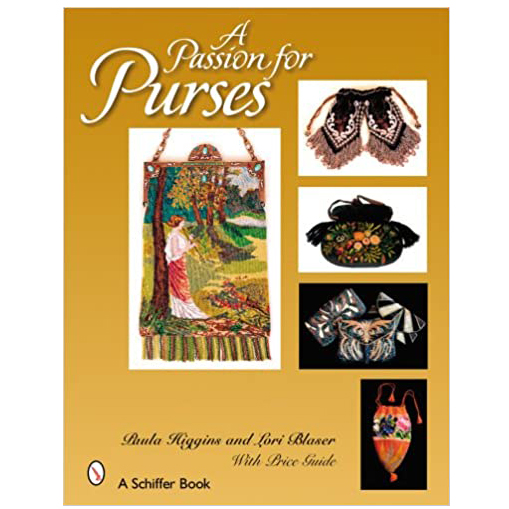“A Passion for Purses” is an excellent reference providing a four hundred year historical overview, then homing on on specific eras and purse types, highlighting the following twelve chapters. Capping it all, Chapter 14 is a candid commentary by Terri Lykins on antique purse restoration which includes advice on when to forget restoration and focus on displaying without causing further deterioration.
This well-written, colorful, detailed book will strike a resonating chord with collectors of other vanity items: compacts, jewelry, linens and lace, lipsticks, and perfume bottles. Usually purses were made and designed for women. Often they were also produced by women, sometimes commercially, but often as personal projects from traditions, patterns, and skills passed from woman to woman. Purses filled occupational and recreational needs. They were learning projects for girls, they were a means of demonstrating a skill; a gift of love and appreciation; a celebrative memorial of a special event; a symbol of fashion sense or social status. They were as personal as handwriting, as useful as shoes, and a canvas for artistic talent.
As with other vanity collectibles, hints of the ere were found in the purpose, materials and the style of the purse. earliest purses contained herbs and spices to combat unpleasant odors. Bags, simple or complex, held the tools of the housewife, seamstress, nurse or traveler. In time of leisure, they held cards and gaming pieces, cosmetic, mirrors and dance cards.
Early purses were knitted, braided, embroidered and crocheted, some done in stitches so complex that the methods have been lost in time. Only the few examples remain. One wonders how these “artists” found the time to learn and practice their art when they lived without electric lights and modern conveniences. Be that as it may, Higgins and Blaser have rounded up information on a and spectacular examples of purses. They have tied the examples to the times and places and events and have sprinkled the text with references for further delving. Expect to trip over some unfamiliar terms. You may have to search through the examples and picture text to find definitions and more answers – but i think it is all there. Obviously this work is the result of the kind of generous sharing of items, photos, expertise and information that we see in the IPBA. Nicely done.
